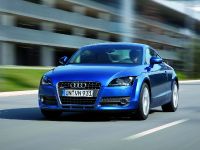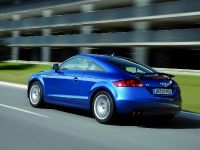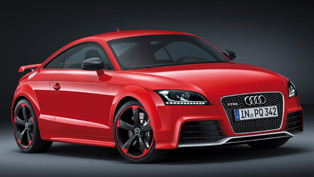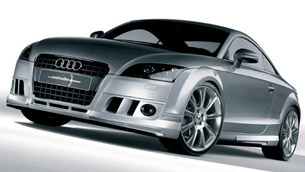The Audi TT 2.0 TDI quattro - Coupe and Roadster
Performance and efficiency
Purist sportiness and compelling performance, combined with sensational efficiency – Audi is setting the trends yet again. The Audi TT Coupe 2.0 TDI quattro and Audi TT Roadster 2.0 TDI quattro are the first series-production sports cars in the world to be powered by diesel engines. The two-liter fourcylinder engine delivers dynamic thrust, with a power output of 125kW (170 hp) and 350 Nm (258.15 lb-ft) of torque. On average, however, the TDI in the TT Coupe requires only 5.3 liters of fuel per 100 km (44.38 mpg) – unbeatably low consumption in the sports car segment.
Trendsetter: Audi sets the pace
Audi is setting the pace with this synthesis of excellent dynamism and low fuel consumption, as it has been doing for many years: Since first appearing in 1989, the TDI engines of the brand with the four rings have set trends for the rest of the automotive industry. Today, these powerful, refined but highly efficient engines represent a modern, smart take on sportiness. The run of victories achieved by the Audi R10 TDI diesel racing car at the Le Mans 24 Hours and in the American Le Mans Series is impressive evidence of the tremendous potential of this technology. The production versions of Audi's diesel engines, too, are noted for their dynamic performance. The TT Coupe quattro with the 2.0 TDI sprints from zero to 100 km/h (62.14 mph) in 7.5 seconds and achieves a top speed of 226 km/h (140.43 mph). The Audi TT Roadster, likewise with quattro permanent all-wheel drive, takes just two-tenths of a second longer in the sprint discipline and has a top speed of 223 km/h (138.57 mph). The TT's low weight is a key factor in this impressive performance. The TDI Coupe tips the scales at just 1,370 kilograms (3,020.30 lb) and the Roadster, with its numerous reinforcing plates, at 1,415 kg (3,119.51 lb).
Both body versions use the hybrid design pioneered by Audi. Their forward structure is made from lightweight aluminum, the rear section comprised of steel – a concept that optimizes weight distribution. The power transmission for the TT Coupe 2.0 TDI quattro and TT Roadster 2.0 TDI quattro is sheer high-tech, too. An ultra-efficient, precise and easy-toshift six-speed manual transmission delivers the engine's torque to the all-wheel drive, itself featuring a hydraulic multi-plate clutch as its nerve center. The clutch can redirect power as needed from the front to the rear wheels with lightning speed. Audi's two new diesel sports cars move along on sporty 16-inch alloy wheels. Their chassis, with electromechanical power steering and elaborate four-link rear suspension, is a highly complex structure. It guarantees a comfortable ride and ensures the car's handling is both dynamic and safe – the key to thrilling, carefree driving enjoyment. The diesel engine puts its particular strengths into play as part of this package – its smooth running, ample pulling power and outstanding efficiency. The TT Coupe 2.0 TDI quattro and TT Roadster 2.0 TDI quattro will be available on the market in the second quarter, starting at EUR 34,850 and EUR 35,900 respectively. Audi, the creator of TDI technology, is set to extend its lead.
Engine
- Four-cylinder TDI with displacement of two liters, 125 kW (170 hp) output and 350 Nm torque (258.15 lb-ft)
- Common rail fuel injection with piezo injectors for highly refined running
- 0 - 100 km/h (62.14 mph) in 7.5 seconds, top speed 226 km/h (140.43 mph) (Coupe)
- Average fuel consumption 5.3 liters/100 km (44.38 mpg) (Coupe) Power transmission
- Precise, highly effective six-speed manual transmission
- quattro all-wheel drive with hydraulic multi-plate clutch Chassis
- Four-link rear suspension for sporty handling and good comfort
- Power steering with highly efficient electric drive Body
- Length 4,178 millimeters (164.49 in), drag coefficient 0.30 (Coupe)
- Trunk capacity 290 to 700 liters (10.24 – 24.71 cubic ft) thanks to folding seat backs (Coupe),
- Dynamic, emotional design, Roadster with classic soft top
- Low weight thanks to innovative hybrid design, aluminum forward structure Interior
- Good amount of space at all seats
- Outstanding ergonomics and clear interior design
- Uncompromising build quality Equipment
- Extensive specification, standard-fit automatic air conditioning (Coupe) and radio system
Power and efficiency
Audi is setting the standard once again, this time with the new Audi TT and its TDI engine – a model that blends purist sportiness, powerful performance and sensational efficiency. The Audi TT Coupe 2.0 TDI quattro and Audi TT Roadster 2.0 TDI quattro are the first series-production sports cars in the world to use a diesel engine as their power source. A fascinating combination: The new two-liter, four-cylinder engine delivers dynamic thrust, with a power output of 125 kW (170 hp) and 350 Nm (258.15 lb-ft) of torque. The TT Coupe quattro with the 2.0 TDI sprints from zero to 100 km/h (62.14 mph) in only 7.5 seconds and achieves a top speed of 226 km/h (140.43 mph). The Audi TT Roadster, likewise featuring quattro permanent all-wheel drive, takes just two-tenths of a second longer in the standard sprint discipline and has a top speed of 223 km/h (138.57 mph). The Coupe consumes on average just 5.3 liters of fuel over 100 km (44.38 mpg), representing CO2 emissions of only 139 grams/km; the figure for the Roadster is 5.5 l/100 km (144 grams of CO2/km). With the TDI in the TT series, Audi once again establishes its role as trendsetter on the diesel market. The brand with the four rings is pushing back the frontiers – starting at the very top. The engine The new four-cylinder TDI with its capacity of 1,968 cm3 signals the advent of a new generation of dynamic, ultra-efficient Audi diesel engines. It interprets the consistently impressive qualities of the TDI concept in a fundamentally new way. The two-liter power unit, featuring two camshafts, builds on the strengths of its predecessor, once the most-manufactured diesel engine in the world – high pulling power, impressive efficiency and refinement.
The new common rail injection system, run by one of the most advanced control units on the market, features ultramodern piezo injectors. Its eight-hole injectors can achieve up to five separate injection processes per combustion cycle. This fine-tuned approach produces a gentle pressure increase in the combustion chambers, decisively reducing the noise level. The single-piston high-pressure pump develops a system pressure of 1,800 bar. This allows fuel to form a fine dispersion, enabling precise, highly efficient combustion. The turbocharger, too, belongs to a new generation. For a swift torque buildup it operates with adjustable vanes, and a special damper reduces its vibration. The engine's intake manifold houses swirl flaps that generate a tumbling action in the inflowing air; electric motors regulate the flaps' position so that this tumble is always adapted perfectly to the load and engine speed. The geometry of the engine's pistons has been optimized, and the acoustics of the camshaft drive belt overhauled. Two balancing shafts reduce the second-degree inertial forces produced by the crankshaft drive. High exhaust gas recirculation: low nitrogen oxide emissions The cumulative result of this progress is a high maximum engine speed of 5,400 rpm and, most importantly, a significant improvement in thermodynamics in the combustion chambers. What this means is that the engine can run to a very large extent on recirculated exhaust gas that has been thoroughly cooled by the radiator. The cooler combustion process involving less oxygen drastically reduces engine emissions of nitrogen oxide. Although the high exhaust gas recirculation rate is in and of itself detrimental to engine efficiency, in typical Audi style the engineers averted any undesirable increase in consumption and in fact turned this state of affairs to their advantage through intensive fine-tuning.
The 2.0 TDI in the Audi TT, with a compression ratio of 16.5:1, delivers 125 kW (170 hp) at 4,200 rpm. It puts a hefty 350 Nm (258.15 lb-ft) onto the crankshaft at engine speeds ranging from 1,750 to 2,500 rpm – the range where power really makes a difference to driving.
The four-cylinder power unit runs with little vibration and responds intently to the accelerator. Its superlative pulling power is available at virtually every engine speed, from rock-bottom upwards. It gives the 2.0 TDI an utterly distinctive, strong character – that of a beefy, clever sport engine. The road performance reflects this character. The Audi TT Coupe 2.0 TDI quattro easily leaves behind the competition with equivalent gasoline engines in midrange acceleration and it sprints from zero to 100 km/h (62.14 mph) in just 7.5 seconds, not looking back until it reaches 226 km/h (140.43 mph). The TT Roadster accelerates to 100 km/h (62.14 mph) in 7.7 seconds and keeps going up to 223 km/h (138.57 mph). The TT Coupe and TT Roadster achieve average fuel consumption of just 5.3 and 5.5 liters of fuel per 100 km (44.38 and 42.77 US mpg) – equating to emissions of 139 and 144 grams of CO2/km respectively. In so doing, Audi is setting a benchmark that represents a veritable quantum leap in the sports car segment. The operating range of over 1,100 km (683.51 miles) on a single tank of fuel (Coupe) expresses this superiority in a directly tangible and impressive way. The Audi slogan "But where's the tank?" from the classic TV commercial now has equal validity for its sports cars.
The TDI version of the TT easily shrugs off the challenge from its gasolineengined competitors, too, when the figures that really count are closely scrutinized. Its specific output is 63.5 kW (86.4 hp) per liter of engine capacity, and its specific torque is all of 177.8 Nm (131.14 lb-ft) per liter. But the most impressive ratio is power to fuel consumption and CO2 emissions: At just 0.90 kW (1.22 hp) per gram/km, the TT 2.0 TDI quattro is truly in a league of its own when it comes to efficiency.
The drivetrain
In keeping with the theme of sporty performance, Audi has equipped its dieselengine sports cars with highly effective manual six-speed transmissions whose short lever travel allows the driver to shift quickly, easily and precisely. The housings for these transmissions are made of lightweight, high-tech magnesium. Relatively long final transmission bring the drivetrain into line with the character of the TDI engine. In light of their immense torque of 350 Nm (258.15 lb-ft), Audi is equipping both of its new TT models with quattro all-wheel drive as standard. This decisively improves traction, slip-free acceleration, drivability, stability and straight-line running in all weather conditions.
The nerve center of the quattro drive in the TT is an electronic-control, hydraulically actuated multi-plate clutch located at the end of the propshaft at the vehicle's rear end – a position that improves the weight distribution. It distributes the torque continuously between the front and rear wheels depending on the driving situation. Thanks to a new pressure reservoir, the clutch works twice as fast as before, within a matter of milliseconds.
The chassis
The sports suspension likewise offers extraordinarily dynamic features. The front suspension – a classic McPherson layout – is pivoted on an aluminum subframe. A highly precise rack-and-pinion steering system with a direct steering ratio provides an intimate link between the driver and the road. Power steering with servo assist, which decreases as speed increases, is generated by an electromechanical drive far more efficient than a hydraulic pump. The coil springs and shock absorbers in the four-link rear axle are situated in separate areas. The control arms, too, are carefully configured: The trailing links, which absorb the propulsive and braking forces, have a relatively soft characteristic to promote ride comfort. The connections to the three transverse links per wheel, on the other hand, are rigid in order to direct transverse forces into the body with precision.
Audi equips the Coupe and Roadster with 16-inch cast alloy wheels as standard, fitted with size 225/55 R 16 tires. Behind the wheels are large disk brakes with pads that develop high coefficients of friction. They measure 312 millimeters (12.28 in) at the front and 286 millimeters (11.26 in) at the rear; the front disks are ventilated. The ESP electronic stabilization program is optimized for a dynamic style of driving. A brief press of a button at lower speeds – e.g. when driving on snow chains – is all it takes to increase wheel slip. A longer press of the button takes the TT driver into a second, sporty operating plane in which the ESP permits controlled sideslip angles. The brakes intervene somewhat later than in normal operation and engine manipulation is suppressed. Audi magnetic ride, a high-tech shock-absorber system available as an option, is an adaptive system that resolves the traditional conflict of interests between comfort and handling. A magneto-rheological fluid circulating in the shock absorbers changes its flow properties within milliseconds when a voltage is applied; this, in turn, alters the damping characteristic. The driver can choose between "Normal" and "Sport" programs by flipping a switch.
The body and interior
The intelligent lightweight design of the Audi TT 2.0 TDI quattro is a key factor in its sporty performance. The 2+2-seater Coupe tips the scales at only 1,370 kilograms (3,020.30 lb) when unladen, with the two-seater Roadster weighing only slightly more at 1,415 kilograms (3,119.51 lb). The open sports car has a classic sport top – this is lightweight, keeps the center of gravity low, blends harmoniously with the overall styling, and occupies minimal space when folded
down.
The low weight is the result of an innovative hybrid-design body developed by Audi. The forward structure is made of light aluminum components assembled using the space frame principle; steel is used for the rear structure. This solution guarantees that the frame is as rigid as possible and optimizes load distribution between the axles. The bodyshell of the Coupe weighs 206 kilograms (454.15 lb); it weighs a bit more in the case of the Roadster – 251 kilograms (553.35 lb) – in view of the special reinforcements it incorporates.
Fascinating: the design
Both body versions present a fascinatingly powerful, emotional design. The 4,178 millimeter (164.49 in) long body comes across as muscular and dynamic. The nose end is dominated by the large single-frame grille, and there is an integral automatically extending spoiler at the rear. Subtle quattro badges identify it as a fundamentally all-wheel-drive vehicle. With drag coefficients of 0.30 (Coupe) and 0.32 (Roadster), Audi demonstrates how good design can produce a low drag coefficient, which translates into a higher top speed and better fuel efficiency. The flowing dynamic style is echoed in the car's interior. The driving area with its clear-cut instruments makes reference to the classic circle motif, as do the air vents and rotary controls for the automatic air conditioning, which has been integrated into the center console angled slightly towards the driver. The sport steering wheel with the flat-bottomed rim rests snugly in the hands. Perfect ergonomics and uncompromisingly high standards of build quality are a question of honor for Audi. The height-adjustable sport seats are deep-set, providing a sporty seated position and firm lateral support. The backs of both rear seats fold down in the TT Coupe, making the trunk space grow from 290 to 700 cubic liters (10.24 – 24.72 cubic ft). The TT Roadster (250 liters (8.83 cubic ft) whether the hood is up or down) can also be supplied with the option of a useful load-through facility with removable ski bag.
The equipment
The standard equipment highlights the sporty character of both diesel-engined TT versions. The interior is accentuated by aluminum-look components in conjunction with inlays in Micrometallic gray. The sports steering wheel comes with a Nappa leather skin. The automatic air conditioning (optional for Roadster) regulates the heating and ventilation. In the event of an accident there are two front and head/thorax airbags ready to protect each occupant of the front seats; the specially shaped seat backs and head restraints shield the driver and front passenger in a rear-end collision. Electric windows and exterior mirrors, the driver information system, front fog lights and the chorus audio system round off the standard specification. The equipment options include an extensive range of high-tech features. These include the electrically adjusted front seats, the dynamic cornering light system by the name of adaptive light, a navigation system that shares the same operating principle as Audi's incomparable MMI concept, and an ultramodern generation of audio systems. In addition to various leather equipment lines, three leather packages are available. The TT Coupe 2.0 TDI quattro and TT Roadster 2.0 TDI quattro will be arriving at dealers in the first half of the year. The enclosed sports car version has a starting price of EUR 34,850 and its open-top counterpart EUR 35,900. TDI engines in motor racing Since first appearing in 1989, Audi's TDI engines have been setting trends for the rest of the automotive industry to follow. With their power, refinement and efficiency, they have come to represent a modern, smart interpretation of sportiness. The run of victories celebrated by the Audi R10 TDI diesel race car at the Le Mans 24 Hours and in the American Le Mans Series is impressive evidence of the tremendous potential of this technology.
The Audi R10 TDI has been blazing a trail since early 2006 – with its twelvecylinder diesel engine it has entered an entirely new dimension. The 5.5 liter TDI is a race engine of superior pedigree. Its torque far surpasses that of any gasoline engine, developing more than 1,100 Nm (811.32 lb-ft). At nominal engine speed it delivers over 650 horsepower, producing a top speed of around 330 kilometers per hour (205.05 mph). The only minor problem encountered right at the start was due to the specific nature of the twelve-cylinder TDI – its very quiet running. The drivers of the open-top prototype – including multiple Le Mans winners such as the Dane Tom Kristensen and the German Frank Biela – had to get used to this fundamentally different attribute. Whereas they had previously been able to rely on the engine's sound as a guide to its performance, above a given speed it was now no longer audible. They soon adapted to the new situation, and the mighty diesel engine has since been demonstrating its strengths with resounding success. Among its virtues is fuel efficiency. Compared with its predecessor, the already very efficient R8 with gasoline direct injection, the Le Mans version of the R10 TDI was markedly more economical. Furthermore the Le Mans circuit, with its long straights and scope for 75 percent use of full throttle, does not provide a true reflection of its strengths. Fewer stops for refueling mean faster times – so high efficiency was the key to two successive victories in the tradition-steeped French endurance race. In 2006 Frank Biela, Emanuele Pirro (Italy) and Marco Werner (Germany) emerged as clear winners, completing 380 laps equivalent to 5,187 km (3223.05 miles) at an average speed of 215.409 km/h (133.849 mph). The same team of drivers again won in 2007, even though the organizers had capped the tank capacity of the R10 TDI. In difficult weather conditions Biela/Pirro/Werner clocked up 369 laps at an average speed of 209.152 km/h (129.961 mph).
The R10 TDI embarked on an impressive string of victories in the American Le Mans Series in the first half of 2006 – it won all eight heats in which it participated during the season. It again went from triumph to triumph in 2007, clinching the Constructors' Trophy in the large LMP 1 category. The 2008 season got under way in mid-March, and Audi again relishes this sizeable challenge.









